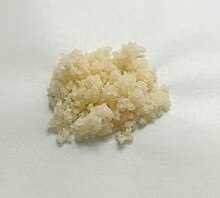Potassium selenocyanate
 | |
 | |
| Identifiers | |
|---|---|
CAS Number |
|
3D model (JSmol) |
|
| ChemSpider |
|
| ECHA InfoCard | 100.020.292 |
| EC Number |
|
PubChem CID |
|
CompTox Dashboard (EPA) |
|
InChI
| |
| |
| Properties | |
Chemical formula | CNKSe |
| Molar mass | 144.08 |
| Appearance | colorless or white solid |
| Density | 2.35 g/cm3 |
Solubility in water | high |
Except where otherwise noted, data are given for materials in their standard state (at 25 °C [77 °F], 100 kPa). Infobox references | |
Potassium selenocyanate is the inorganic compound with the formula KSeCN. It is a hygroscopic white solid that is soluble in water, decomposing in air to red selenium and potassium cyanide. The compound has been characterized by X-ray crystallography, which confirms that it is a salt. The C-N and C-Se distances are 112 and 183 pm, respectively consistent with triple and single bonds.[1]
Synthesis and reactions
Potassium selenocyanate is produced by the reaction of molten potassium cyanide with elemental selenium.[2]
Organic selenocyanates are often prepared by treatment of potassium selenocyanate with alkyl halides or aryl diazonium salts.[2]
Potassium selenocyanate serves as a source of Se0, e.g., in its reaction with triphenylphosphine to give triphenylphosphine selenide.[3]
References
- ^ Swank, Duane D.; Willett, Roger D. (1965). "The Crystal Structure of Potassium Selenocyanate". Inorganic Chemistry. 4: 499–501. doi:10.1021/ic50026a013.
- ^ a b E. Bulka (1977). "Selenocyanates and Related Compounds". In Saul Patai (ed.). Cyanates and Their Thio Derivatives: Part 2, Volume 2. PATAI'S Chemistry of Functional Groups. p. 619-818. doi:10.1002/9780470771532.ch3.
- ^ Nicpon, Philip; Meek, Devon W. (1967). "Triphenylphosphine Selenide". Inorganic Syntheses. 10: 157–159. doi:10.1002/9780470132418.ch23.
- v
- t
- e
| HCN | He | ||||||||||||||||||||
| LiCN | Be(CN)2 | B(CN)3 | C(CN)4 C2(CN)2 | NH4CN ONCN O2NCN N3CN | OCN− -NCO O(CN)2 | FCN | Ne | ||||||||||||||
| NaCN | Mg(CN)2 | Al(CN)3 | Si(CN)4 (CH3)3SiCN | P(CN)3 | SCN− -NCS (SCN)2 S(CN)2 | ClCN | Ar | ||||||||||||||
| KCN | Ca(CN)2 | Sc(CN)3 | Ti | V | Cr(CN)63− | Mn | Fe(CN)2 Fe(CN)64− Fe(CN)63− | Co(CN)2 Co(CN)3− 5 | Ni(CN)2 Ni(CN)42− Ni(CN)44− | CuCN | Zn(CN)2 | Ga(CN)3 | Ge(CN)2 Ge(CN)4 | As(CN)3 (CH3)2AsCN (C6H5)2AsCN | SeCN− (SeCN)2 Se(CN)2 | BrCN | Kr | ||||
| RbCN | Sr(CN)2 | Y(CN)3 | Zr | Nb | Mo(CN)84− | Tc | Ru | Rh | Pd(CN)2 | AgCN | Cd(CN)2 | In(CN)3 | Sn(CN)2 | Sb(CN)3 | Te(CN)2 Te(CN)4 | ICN | Xe | ||||
| CsCN | Ba(CN)2 | * | Lu(CN)3 | Hf | Ta | W(CN)84− | Re | Os | Ir | Pt(CN)42- Pt(CN)64- | AuCN Au(CN)2- | Hg2(CN)2 Hg(CN)2 | TlCN | Pb(CN)2 | Bi(CN)3 | Po | At | Rn | |||
| Fr | Ra | ** | Lr | Rf | Db | Sg | Bh | Hs | Mt | Ds | Rg | Cn | Nh | Fl | Mc | Lv | Ts | Og | |||
| * | La(CN)3 | Ce(CN)3 Ce(CN)4 | Pr(CN)3 | Nd | Pm | Sm(CN)3 | Eu(CN)3 | Gd(CN)3 | Tb | Dy(CN)3 | Ho(CN)3 | Er | Tm | Yb(CN)3 | |||||||
| ** | Ac(CN)3 | Th(CN)4 | Pa | UO2(CN)2 | Np | Pu | Am | Cm | Bk | Cf | Es | Fm | Md | No | |||||||











